
|
"Outstanding keeper instruction. This is a must for goalkeepers and coaches." — Ottawa Internationals S.C. web site, Ottawa, Canada |

|

|
|
|
Top |
Next: Tactics
|
He was the first goalkeeper who had the audacity to leave the penalty area and lead the attack. Heightening the danger, on more than one occasion this Argentine even took the enormous risk of dribbling past opposing players. Before Carrizo, such insanity was unthinkable. Then his audacity caught on.
— Eduardo Galeano, Soccer in Sun and Shadow
| CONTENTS | TRAINING SESSIONS |
|---|---|
|
Punts and Drop Kicks
Goal Kicks Throws Quick Summary/Mistakes to Watch For Related Blog Entries |
Kicks
Throws |
The goalkeeper is the last line of defense, but also the first line of attack. I am not advocating attempting to dribble the entire field starting from your own goal like Amadeo Carrizo, but a quick restart to the attack can be very effective. After a save is made, the keeper must quickly look to break out and start the counter. This is especially true after the Laws change of July 1, 2000 eliminating the four-step limitation and requiring the goalkeeper to put the ball back in play after 5-6 seconds.
Distribution can be done two ways: throws or kicks. Both have advantages for certain situations.
Kicks
A goalkeeper may simply drop the ball to the ground and take the kick normally, especially if they have a big foot. When more distance is required, to break pressure or for younger players, a punt or drop kick is used.
- Punts

 A punt is usually the kick with the greatest distance, although the high
trajectory and hang time usually mean 50-50 balls at the receiving end.
A punt is usually the kick with the greatest distance, although the high
trajectory and hang time usually mean 50-50 balls at the receiving end.
 Start with the ball in both hands.
It may be more comfortable to end up dropping the ball with one
hand rather than two. If so, the hand on the same side as the kicking
foot should be used (you'll see this in the video clip). But starting
with both hands will allow for more consistency in the drop.
Take a short run up (about 2-3 steps) at a slight angle to the kicking direction; this gets the
hip more involved and generates more power.
Start with the ball in both hands.
It may be more comfortable to end up dropping the ball with one
hand rather than two. If so, the hand on the same side as the kicking
foot should be used (you'll see this in the video clip). But starting
with both hands will allow for more consistency in the drop.
Take a short run up (about 2-3 steps) at a slight angle to the kicking direction; this gets the
hip more involved and generates more power.
 The plant foot should point
towards the target. Drop the ball -
The plant foot should point
towards the target. Drop the ball -  don't
toss it upwards! - and kick, following through to land on the kicking
foot.
The kicking foot should be straight, directly on line with the
target, and
don't
toss it upwards! - and kick, following through to land on the kicking
foot.
The kicking foot should be straight, directly on line with the
target, and  should not swing around
the body.
should not swing around
the body.
- Drop Kicks

 A drop kick, where the ball hits the ground before being contacted by
the foot, gives a lower trajectory ball. This makes it better for
driving into the wind and makes it easier for teammates to receive. It
does not have quite the distance of a punt, however. The technique is
very much the same as a punt, except the kick is timed so the foot
strikes the ball just after it bounces on the ground.
The drop kick has a
A drop kick, where the ball hits the ground before being contacted by
the foot, gives a lower trajectory ball. This makes it better for
driving into the wind and makes it easier for teammates to receive. It
does not have quite the distance of a punt, however. The technique is
very much the same as a punt, except the kick is timed so the foot
strikes the ball just after it bounces on the ground.
The drop kick has a  distinctive "ba-DUM" sound you can listen for: the
"ba" is the ball hitting the ground; the "DUM" is the foot striking the
ball a fraction of a second later.
distinctive "ba-DUM" sound you can listen for: the
"ba" is the ball hitting the ground; the "DUM" is the foot striking the
ball a fraction of a second later.
Timing is everything for both punts and drop kicks.
![]() Just like free-throw
shooting in basketball, kicking distribution must be practiced over and
over until the timing becomes automatic. Don't be discouraged when
kicks are very inconsistent at first - time and lots of practice will
improve things.
Just like free-throw
shooting in basketball, kicking distribution must be practiced over and
over until the timing becomes automatic. Don't be discouraged when
kicks are very inconsistent at first - time and lots of practice will
improve things.
Goal Kicks
As with punts and drop kicks, technique is the key. Power is usually less of an issue than the ability to get some loft on the ball to increase the distance. Keys to getting a good goal kick are:
-
Approach the ball from a slight angle. This will allow the hip flexor to get involved more and generate more leg speed.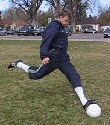
Fig. 1: Long stride  Make
sure the follow through is straight at the target, though.
Make
sure the follow through is straight at the target, though.
- The ankle of the plant foot should be just behind the ball and the
body should be leaning back. This differs from shooting technique!
 If the plant
foot is too close to the ball, it will be difficult to get any height on
the kick.
If the plant
foot is too close to the ball, it will be difficult to get any height on
the kick.
-
The final step into the kick should be a long, smooth stride (Fig. 1). This also
helps generate leg speed. A
 short, choppy run-up won't allow a proper leg swing.
short, choppy run-up won't allow a proper leg swing.
-
The toe needs to be pointed slightly outwards (ankle locked!) in order to get the foot under the ball (Fig. 2). This is probably the most crucial point. Although a goal kick is an instep drive, you want to use the inside of the shoelaces, not the top.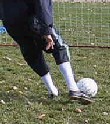
Fig. 2: Foot angle  The foot should be angled outward so the
contact point is on the lower half of the ball, just above the first
joint of the big toe on the inside of the instep (Fig. 3). An analogy I like to use is that
of a golf wedge versus a driver. The foot should be more like a wedge
in order to get under the ball and give the it proper trajectory and
distance.
The foot should be angled outward so the
contact point is on the lower half of the ball, just above the first
joint of the big toe on the inside of the instep (Fig. 3). An analogy I like to use is that
of a golf wedge versus a driver. The foot should be more like a wedge
in order to get under the ball and give the it proper trajectory and
distance.
-
If the kicks are long but tend to curl and affect accuracy, watch the point where the foot strikes the ball. With an angled approach and long swing, the natural tendency will be to hit an "inswinging" ball; to counteract this,
Fig. 3: Ball contact  the strike point should be just to the "inside" of the ball
(just to the left of center
on the ball for a right footed kicker, vice versa for lefties).
the strike point should be just to the "inside" of the ball
(just to the left of center
on the ball for a right footed kicker, vice versa for lefties).
If a keeper is struggling to get the ball off the ground, it can be helpful to try working off a "tee" at first: a tall tuft of grass, flat cone, etc. This will allow more space to get under the ball. Once that is working well, lower the ball. You shouldn't need a specialized keeper coach to help with goal kicks; any good soccer coach should be able to help you tune up your place kick.
A final word on kicks: let your good technique do the work for you!
![]() A keeper who tries
too hard to "explode" the ball will likely mis-hit the ball and suffer
inconsistency. Relax, and let the mechanics of the kick work for you.
A keeper who tries
too hard to "explode" the ball will likely mis-hit the ball and suffer
inconsistency. Relax, and let the mechanics of the kick work for you.
Throws
Throws are usually much shorter than kicks, but much more accurate. A quick throw right to the feet of an open teammate is often the safest distribution. The goalkeeper has several basic throws available. I've listed them here in order of decreasing accuracy and increasing distance.For the javelin, sidearm and overhand throw, the trajectory of the soccer ball should be mostly level or even downwards, not high and looping. We want the ball to hit the ground in front of the receiver, to give it time to settle on the grass and make for an easy trap. A rule of thumb is to have the ball initially hit the ground about two-thirds of the way to the receiver.
-

Fig. 4: The Roll
 Roll
Roll
The roll (Fig. 4) is the most accurate but shortest distribution. It is also typically the easiest for teammates to receive. Control the ball between the palm of the hand and the forearm with a bent wrist, step with the opposite foot, and "bowl" the ball, making sure the fingertips touch the ground on the delivery. This will require bending the knees and waist to get low enough. Just
like in real bowling, you don't want to drop the ball from the hand
to the ground. The transition should be smooth.
Just
like in real bowling, you don't want to drop the ball from the hand
to the ground. The transition should be smooth.
-
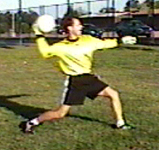
Fig. 5: Javelin Throw
 Javelin or Baseball Throw
Javelin or Baseball Throw
In the middle of the accuracy and distance scale is the javelin or baseball throw (Fig. 5). The form is similar to how a javelin is thrown. The ball starts in the palm beside the head and is thrown straight forward as the keeper steps into the throw. Some backspin on the ball will help it "sit down" and make it easier to receive, so the keeper can let the ball roll of their fingertips slightly at the end of the release to provide this. Make sure the fingers
are slightly over the top of the ball to keep
it on a level or downward trajectory.
fingers
are slightly over the top of the ball to keep
it on a level or downward trajectory.
-
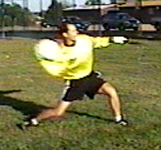
Fig. 6: Sidearm Throw
 Sidearm Throw
Sidearm Throw
The sidearm throw (Fig. 6) lies between the javelin and overhand throw in both distance and accuracy, and also in its delivery. The arm is extended back slightly behind the body at a "three-quarters" angle, not straight to the side but just below shoulder level. The ball is delivered with a bit of a slinging, sweeping motion. Because the arm position is sideways, the best way to put backspin on this throw is by passing the palm of the hand under the ball upon release, letting the ball roll off the middle and index finger and the thumb. Again, keep
the fingers over the top of the ball so it stays low.
keep
the fingers over the top of the ball so it stays low.
-
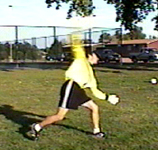
Fig. 7: Overhand Throw
 Overhand Throw
Overhand Throw
The overhand throw or "sling" is the longest but least accurate throw (Fig. 7). It can be a good technique for very young players, since sometimes they can actually throw it as far as they can punt. The soccer ball is again controlled between the palm and forearm with a bent wrist. The arm is placed almost straight back, and as the keeper steps into the throw, the arm is fully extended, elbow locked, and brought around in a circle,
over the head, and released towards the target. The hand should end
pointing at the target, and letting the fingertips roll under the ball
at the finish can provide some backspin to help the ball roll smoothly.
fully extended, elbow locked, and brought around in a circle,
over the head, and released towards the target. The hand should end
pointing at the target, and letting the fingertips roll under the ball
at the finish can provide some backspin to help the ball roll smoothly.
This is technically the most difficult throw. The hand must stay on top of the ball throughout the 180 degrees or so of arc;
 centrifugal
force keeps the ball in place, much like water stays in a bucket when
it's whirled around on a rope. The elbow must remain locked until the
release, and the release point is critical. Often times
centrifugal
force keeps the ball in place, much like water stays in a bucket when
it's whirled around on a rope. The elbow must remain locked until the
release, and the release point is critical. Often times
 the elbow will bend as the ball comes
over the head, destroying the flow of the throw. Make sure the elbow
stays locked, the ball comes high over the head, and then is released.
the elbow will bend as the ball comes
over the head, destroying the flow of the throw. Make sure the elbow
stays locked, the ball comes high over the head, and then is released.
Quick Summary - Kick Distribution: |
Mistakes to Watch For: |
||||||||||||||||
|
|
|
||||||||||||||||
Quick Summary - Throw Distribution: |
Mistakes to watch for: |
||||||||||||||||
|
|
|
|
|
Top |
Next: Tactics
|